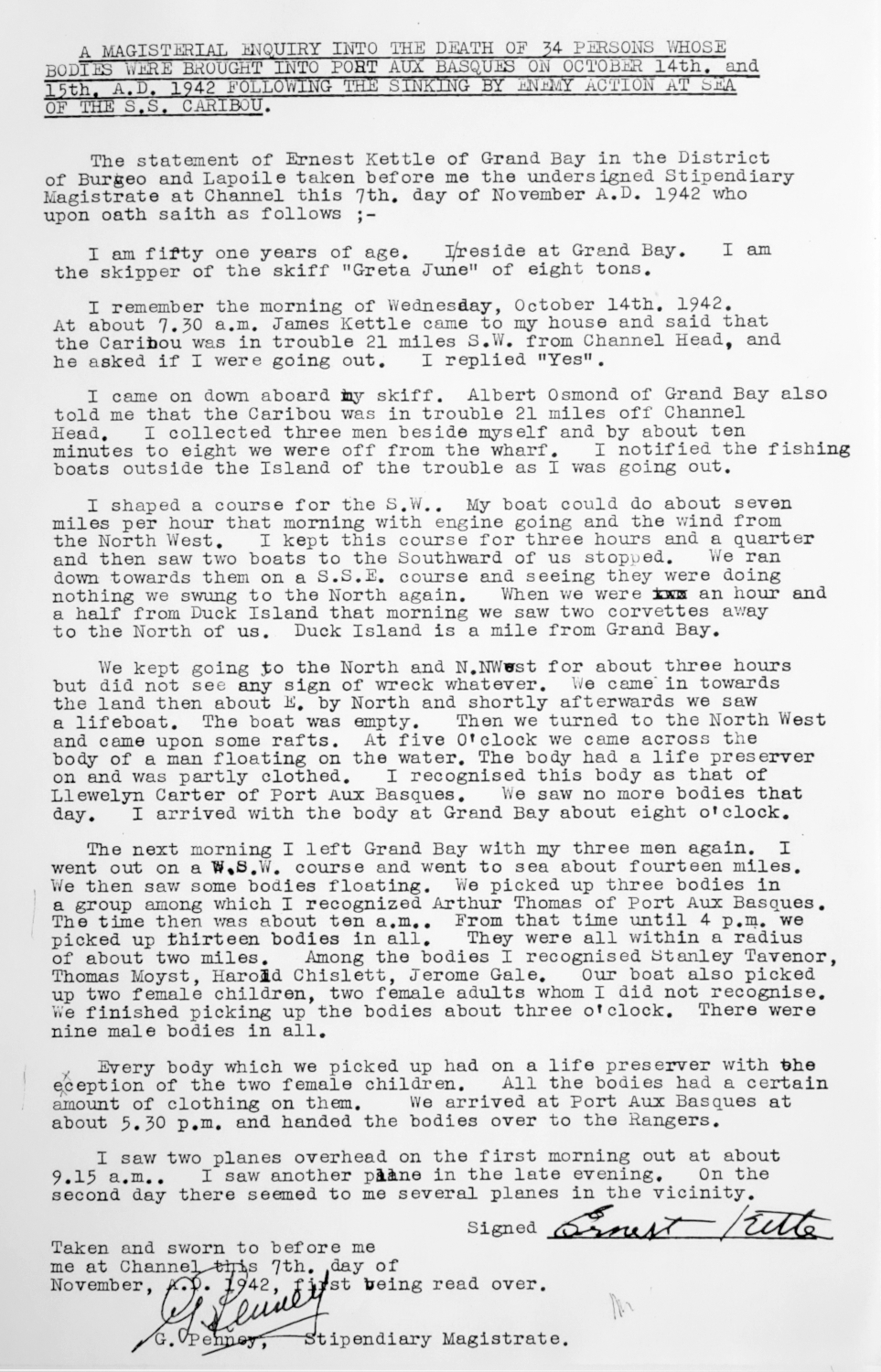Statement of fisherman Ernest Kettle on the recovery of bodies

Audio:
read by Neil Burgess, Shipwreck Preservation Society of Newfoundland & Labrador Inc.
G. Penny, 1943, A Magisterial Enquiry into the Deaths of 34 Persons Whose Bodies were Recovered from the Sea Off Channel Head and Landed at Port aux Basques and Grand Bay on October 14th and 15th, 1942, Subsequent to the Sinking by Enemy Action in Cabot Strait of the “S.S. Caribou”.
Memorial University of Newfoundland, Archives & Special Collections, Cassie Brown collection, COLL-115, file 12.01.001
This statement is by Ernest Kettle, who was a fisherman from Grand Bay, Newfoundland. He gave it on November 7, 1942 to the Magisterial Enquiry on the recovery of bodies from the sinking of S.S. Caribou:
“I am fifty one years of age. I reside at Grand Bay. I am the skipper of the skiff “Greta June” of eight tons.
“I remember the morning of Wednesday, October 14th 1942. At about 7:30 a.m. James Kettle came to my house and said that the Caribou was in trouble 21 miles S.W. from Channel Head, and he asked if I were going out. I replied “Yes”.
“I came down aboard my skiff. Albert Osmond of Grand Bay also told me that the Caribou was in trouble 21 miles off Channel Head. I collected three men beside myself and by about ten minutes to eight we were off from the wharf. I notified the fishing boats outside the Island of the trouble as I was going out.
“I shaped a course for the S.W. My boat could do about seven miles per hour that morning with engine going and the wind from the North West. I kept this course for three hours and a quarter and then saw two boats to the Southward of us stopped. We ran down towards them on a S.S.E course and seeing they were doing nothing we swung to the North again. When we were an hour and a half from Duck Island that morning, we saw two corvettes away to the North of us. Duck Island is a mile from Grand Bay.
“We kept going to the North and N.N.West for about three hours but did not see any sign of wreck whatever. We came in towards the land then about E. by North shortly afterwards we saw a lifeboat. The boat was empty. Then we turned to the North West and came upon some rafts. At five o’clock we came across the body of a man floating on the water. The body had a life preserver on and was partly clothed. I recognized this body as that of Llewelyn Carter of Port Aux Basques. We saw no more bodies that day. I arrived with the body at Grand Bay about eight o’clock.
“The next morning I left Grand Bay with my three men again. I went out on a W.S.W. course and went to sea about fourteen miles. We then saw some bodies floating. We picked up three bodies in a group, among which I recognized Arthur Thomas of Port Aux Basques. The time then was about ten a.m. From that time until 4 p.m. we picked up thirteen bodies in all. They were all within a radius of about two miles. Among the bodies, I recognized Stanley Tavenor, Thomas Moyst, Harold Chislett, and Jerome Gale. Our boat also picked up two female children, two female adults whom I did not recognize. We finished picking up the bodies about three o’clock. There were nine male bodies in all.
“Every body which we picked up had on a life preserver with the exception of the two female children. All the bodies had a certain amount of clothing on them. We arrived at Port Aux Basques at about 5:30 p.m. and handed the bodies over to the Rangers.
“I saw two planes overhead on the first morning out at about 9:15 a.m. I saw another plane in the late evening. On the second day there seemed to me several planes in the vicinity.
Signed Ernest Kettle”
This statement was part of the report of “A Magisterial Enquiry into the Deaths of 34 Persons Whose Bodies were Recovered from the Sea Off Channel Head and Landed at Port aux Basques and Grand Bay on October 14th and 15th, 1942, Subsequent to the Sinking by Enemy Action in Cabot Strait of the “S.S. Caribou”.” This report was dated February 13, 1943 and was written by Stipendiary Magistrate G. Penney.

